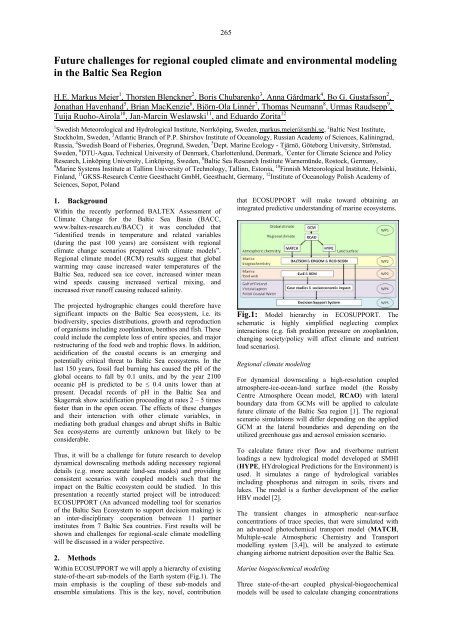Low (web) Quality - BALTEX
Low (web) Quality - BALTEX
Low (web) Quality - BALTEX
Create successful ePaper yourself
Turn your PDF publications into a flip-book with our unique Google optimized e-Paper software.
265<br />
Future challenges for regional coupled climate and environmental modeling<br />
in the Baltic Sea Region<br />
H.E. Markus Meier 1 , Thorsten Blenckner 2 , Boris Chubarenko 3 , Anna Gårdmark 4 , Bo G. Gustafsson 2 ,<br />
Jonathan Havenhand 5 , Brian MacKenzie 6 , Björn-Ola Linnér 7 , Thomas Neumann 8 , Urmas Raudsepp 9 ,<br />
Tuija Ruoho-Airola 10 , Jan-Marcin Weslawski 11 , and Eduardo Zorita 12<br />
1 Swedish Meteorological and Hydrological Institute, Norrköping, Sweden, markus.meier@smhi.se, 2 Baltic Nest Institute,<br />
Stockholm, Sweden, 3 Atlantic Branch of P.P. Shirshov Institute of Oceanology, Russian Academy of Sciences, Kaliningrad,<br />
Russia, 4 Swedish Board of Fisheries, Öregrund, Sweden, 5 Dept. Marine Ecology - Tjärnö, Göteborg University, Strömstad,<br />
Sweden, 6 DTU-Aqua, Technical University of Denmark, Charlottenlund, Denmark, 7 Center for Climate Science and Policy<br />
Research, Linköping University, Linköping, Sweden, 8 Baltic Sea Research Institute Warnemünde, Rostock, Germany,<br />
9 Marine Systems Institute at Tallinn University of Technology, Tallinn, Estonia, 10 Finnish Meteorological Institute, Helsinki,<br />
Finland, 11 GKSS-Research Centre Geesthacht GmbH, Geesthacht, Germany, 12 Institute of Oceanology Polish Academy of<br />
Sciences, Sopot, Poland<br />
1. Background<br />
Within the recently performed <strong>BALTEX</strong> Assessment of<br />
Climate Change for the Baltic Sea Basin (BACC,<br />
www.baltex-research.eu/BACC) it was concluded that<br />
“identified trends in temperature and related variables<br />
(during the past 100 years) are consistent with regional<br />
climate change scenarios prepared with climate models”.<br />
Regional climate model (RCM) results suggest that global<br />
warming may cause increased water temperatures of the<br />
Baltic Sea, reduced sea ice cover, increased winter mean<br />
wind speeds causing increased vertical mixing, and<br />
increased river runoff causing reduced salinity.<br />
The projected hydrographic changes could therefore have<br />
significant impacts on the Baltic Sea ecosystem, i.e. its<br />
biodiversity, species distributions, growth and reproduction<br />
of organisms including zooplankton, benthos and fish. These<br />
could include the complete loss of entire species, and major<br />
restructuring of the food <strong>web</strong> and trophic flows. In addition,<br />
acidification of the coastal oceans is an emerging and<br />
potentially critical threat to Baltic Sea ecosystems. In the<br />
last 150 years, fossil fuel burning has caused the pH of the<br />
global oceans to fall by 0.1 units, and by the year 2100<br />
oceanic pH is predicted to be ≤ 0.4 units lower than at<br />
present. Decadal records of pH in the Baltic Sea and<br />
Skagerrak show acidification proceeding at rates 2 – 5 times<br />
faster than in the open ocean. The effects of these changes<br />
and their interaction with other climate variables, in<br />
mediating both gradual changes and abrupt shifts in Baltic<br />
Sea ecosystems are currently unknown but likely to be<br />
considerable.<br />
Thus, it will be a challenge for future research to develop<br />
dynamical downscaling methods adding necessary regional<br />
details (e.g. more accurate land-sea masks) and providing<br />
consistent scenarios with coupled models such that the<br />
impact on the Baltic ecosystem could be studied. In this<br />
presentation a recently started project will be introduced:<br />
ECOSUPPORT (An advanced modelling tool for scenarios<br />
of the Baltic Sea Ecosystem to support decision making) is<br />
an inter-disciplinary cooperation between 11 partner<br />
institutes from 7 Baltic Sea countries. First results will be<br />
shown and challenges for regional-scale climate modelling<br />
will be discussed in a wider perspective.<br />
2. Methods<br />
Within ECOSUPPORT we will apply a hierarchy of existing<br />
state-of-the-art sub-models of the Earth system (Fig.1). The<br />
main emphasis is the coupling of these sub-models and<br />
ensemble simulations. This is the key, novel, contribution<br />
that ECOSUPPORT will make toward obtaining an<br />
integrated predictive understanding of marine ecosystems.<br />
Fig.1: Model hierarchy in ECOSUPPORT. The<br />
schematic is highly simplified neglecting complex<br />
interactions (e.g. fish predation pressure on zooplankton,<br />
changing society/policy will affect climate and nutrient<br />
load scenarios).<br />
Regional climate modeling<br />
For dynamical downscaling a high-resolution coupled<br />
atmosphere-ice-ocean-land surface model (the Rossby<br />
Centre Atmosphere Ocean model, RCAO) with lateral<br />
boundary data from GCMs will be applied to calculate<br />
future climate of the Baltic Sea region [1]. The regional<br />
scenario simulations will differ depending on the applied<br />
GCM at the lateral boundaries and depending on the<br />
utilized greenhouse gas and aerosol emission scenario.<br />
To calculate future river flow and riverborne nutrient<br />
loadings a new hydrological model developed at SMHI<br />
(HYPE, HYdrological Predictions for the Environment) is<br />
used. It simulates a range of hydrological variables<br />
including phosphorus and nitrogen in soils, rivers and<br />
lakes. The model is a further development of the earlier<br />
HBV model [2].<br />
The transient changes in atmospheric near-surface<br />
concentrations of trace species, that were simulated with<br />
an advanced photochemical transport model (MATCH,<br />
Multiple-scale Atmospheric Chemistry and Transport<br />
modelling system [3,4]), will be analyzed to estimate<br />
changing airborne nutrient deposition over the Baltic Sea.<br />
Marine biogeochemical modeling<br />
Three state-of-the-art coupled physical-biogeochemical<br />
models will be used to calculate changing concentrations













